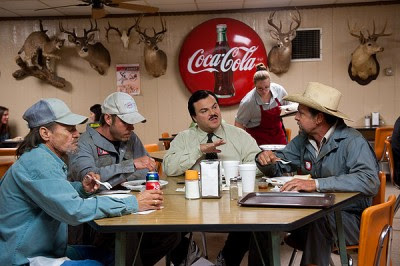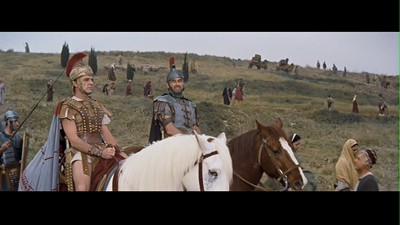I used to have a Thanksgiving ritual
involving The Last Waltz. I
am not unique in this. If you google “Thanksgiving movie,” Martin
Scorsese's 1978 documentary is pretty much the first thing to pop up.
And I didn't even invent my ritual, I stepped into it.
Years ago when I
still lived in Portland, OR, I would spend most holidays on my own.
It started when I was originally a comic book editor and was
essentially looking for any time where I might have peace. Holidays
proved a good option. Everyone's attention was focused elsewhere, and
so I could be by myself, uninterrupted. This meant dodging
invitations and making excuses to family, but it was worth it if it
meant I could stay home and get drunk with my cat and marathon movies
all day. It wasn't me being antisocial so much as being pro-Me. Ron
Swanson would understand.

When I had moved
into the upper Northwest in the early '00s, it put me within blocks
of a place called The Stepping Stone Café. They were open for the
holiday breakfast shift, and I would take myself down there and grab
a seat at the counter, order a fat stack of pancakes they called
“Mancakes”--no joke, the triple stack was over six-inches thick
and the size of the whole plate--and just gorge myself. Most of the
time my actual holiday meal later would be something like a turkey
sandwich with cranberry, or whatever diminutive version of a
Thanksgiving spread I could find in the store that was easy to
prepare, so I could eat as much as I wanted for breakfast, I didn't
have to keep room. Not to mention this would be the base I would pour
whiskey on for the next 10-12 hours.
Those
Thanksgiving mornings, the Stepping Stone would play The
Last Waltz. Now, if you haven't
seen it--or even if you had and your memory is just poor because you
got totally blotto after doing so--you might be wondering how a
documentary showcasing the final concert of 1970s roots rockers The
Band is a Thanksgiving film. The answer is simple: they recorded the
show on Thanksgiving. And guitarist/singer Robbie Robertson at one
point thanks the audience for spending the day with them. Pretty
straightforward.

You
could tell the staff at the Stepping Stone knew the movie by heart,
and they each had their moment where you could see them paying
attention. Like if it were me I'd perk up when Neil Diamond came on,
and I'd take a bathroom break when it was Van Morrison, who looks and
sounds like a troll, let's be honest. (It's okay to hate him now,
right? His caustic old age has vindicated me, yeah?) Whatever chunk
I'd see was the chunk I'd see, it was not planned, it was reliant on
when they hit play versus when I arrived. That was my exposure to The
Last Waltz. Playing the
soundtrack in the background as I type, I can actually smell the
maple syrup.
For
those not really in the know, stumbling on this review wondering if
this Criterion disc is worth picking up or if you should rent/stream
the film somewhere, The Last Waltz
is a combination concert film and denouement. Scorsese interlaces
interviews with members of the group with performance footage. The
songs we hear are not just from The Band, but their collaborations
with famous guests like the aforementioned Diamond and Morrison, Neil
Young, Joni Mitchell, Ringo Starr, Emmylou Harris, Bob Dylan, and
many more. It's a celebration not just of this particular combo, but
of a certain era of rock-and-roll. Scorsese's cut is joyful and
funny, and slyly introspective, cherry-picking moments that reveal
what the music has meant and what is passing.

Of course, having
established themselves as the backing section when Dylan went
electric, whatever these guys did would get attention, particularly
from the peers who agreed to pop up for this farewell. Not to mention
the clutch of solid records and handful of genuine hits--“Up On
Cripple Creek,” “The Weight,” “Ophelia,” etc.--that
followed, legitimizing them as a songwriting force in their own
right. This set is all killer and no filler.
That
said, I, for one, agree with drummer/singer Levon Helm that there is
too much Robertson. But I also got a shitty email once from Robbie
Robertson so maybe I am biased. I was trying to get him to write an
introduction for a comic book I was editing called Skinwalker
that I felt he'd have an affinity for. He declined via his assistant,
whom he instructed to mansplain what a skinwalker was. Which clearly
showed he hadn't even looked at the comic. Call me Team Levon.
Come on, though,
let's be fair, when you think of The Band, the first voice you hear
in your head is Levon Helm. His verse on “The Weight”? Top of the
heap!
And then the next
voice you'll hear is that of bassist Rick Danko. So Robbie Robertston
isn't even top 2.
Team Levon.
Funny
thing, I am not entirely sure I had ever watched the full run of The
Last Waltz in one go before this
Criterion edition. I may have only just seen pieces at The Stepping
Stone, despite owning a previous release as part of a Scorsese boxed
set. The Band isn't really the sort of thing I listen to on the
regular; I've never owned their music as a piece of physical media
beyond that DVD and now this Blu-Ray. But I saw random 45 minute
hunks of it so many Thanksgivings in a row, it feels like it's in my
bloodstream, and I love it regardless of my personal fandom
otherwise. Granted, the picture and sound here are both so sweet, it
does feel like the first time regardless. Technology has a weird way
of making the familiar seem revelatory.

2014
was the last year I was in Portland, though I did visit the city for
the Thanksgiving weekend a couple of years back and made my way from
my hotel to that old cafe to get my Mancakes and my dose of Levon,
Rick, Garth, and the rest (including Robbie). Even if I am a guy not
often prone to nostalgia, it still felt pretty good. No idea if they
were playing the same copy of The Last Waltz that
I had seen so many years prior or if they will now upgrade to a
Criterion disc, maybe even 4K who knows--it doesn't really matter.
The first time or the fifth time or the time that feels like a second
first, it's all of a piece, it's ingrained now, the maple syrup
always tastes good.
This disc provided by the Criterion Collection for purposes of review.













































